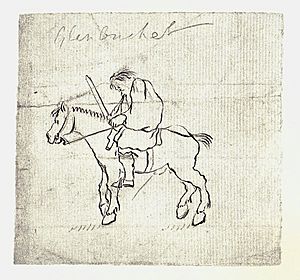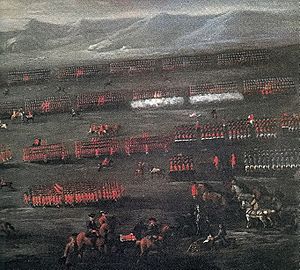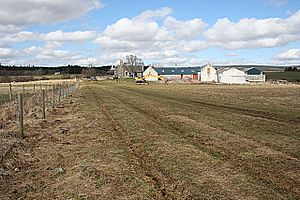John Gordon of Glenbucket facts for kids
Quick facts for kids
John Gordon of Glenbucket
|
|
|---|---|

A drawing of Glenbucket from his time; he was said to ride a "little grey Highland beast".
|
|
| Nickname(s) | "Old Glenbucket" |
| Born | 1673 Aberdeenshire |
| Died | 16 June 1750 (aged 76–77) Boulogne |
| Allegiance | |
| Rank | Jacobite Major General |
| Unit | Glenbucket's Regiment |
| Battles/wars | 1689 Jacobite Rising Killiecrankie 1715 Jacobite Rising Dunfermline Sheriffmuir 1745 Jacobite Rising Culloden |
John Gordon of Glenbucket (around 1673 – 16 June 1750) was a Scottish Jacobite. This means he supported the House of Stuart family's claim to the British throne. He owned a small estate in Aberdeenshire, Scotland.
Glenbucket fought in several Jacobite uprisings. After the 1745 rising failed, where he was a Major-General, he escaped to Norway. He later settled in France and died there in 1750.
Some people saw Glenbucket as a romantic hero. However, he was also a complex figure. He worked for the government at times between 1715 and 1745. He was also known for gathering men for the Jacobite army in 1745.
Contents
Who Was John Gordon of Glenbucket?
John Gordon was born in 1673. His family was a smaller branch of the Clan Gordon. His grandfather, George, managed land at Tap o' Noth. In 1701, John's father, John Gordon of Knockespock, bought the small estate of Glenbucket. This estate was near Kildrummy in Aberdeenshire.
When he was about sixteen, Glenbucket may have fought for the Jacobites at the Battle of Killiecrankie. The Jacobites won this battle, but their leader was killed. The uprising then ended. We don't know much else about his early life. He did attend King's College, Aberdeen at the same time as Simon Fraser, 11th Lord Lovat.
Glenbucket's Role in the 1715 Jacobite Rising
The 1715 Jacobite Rising began after Queen Anne died. It was started by the Tory Earl of Mar. This happened without the full approval of the Jacobite claimant, James Stuart.
Glenbucket worked for the Marquess of Huntly. This job meant he had to provide soldiers when needed. When Huntly joined the uprising, Glenbucket gathered men in Strathbogie. He then led one of the Gordon battalions at the Battle of Sheriffmuir. This battle had no clear winner.
After the uprising failed, Glenbucket and his men surrendered in March 1716. Huntly helped him, suggesting Glenbucket could be useful to the government. Glenbucket was held in Edinburgh Castle and then Carlisle. He was released without charges in late 1716. He promised to serve the King and government loyally.
As a manager for the Gordon estates, Glenbucket became very influential. Both Jacobites and the government wanted his support during the 1719 rising. Glenbucket refused to join the Jacobites. Instead, he gave regular reports to the government about rebel activities. This uprising ended with the Jacobite defeat at Battle of Glen Shiel in June.
Glenbucket's Later Jacobite Activities

Around this time, Glenbucket started talking regularly with the exiled Stuart family. Many Scottish and English nobles did this as a backup plan. In 1728, the Catholic 2nd Duke of Gordon died. His Protestant son, Cosmo 3rd Duke of Gordon, took over. This might have made Glenbucket's role as a link to the Stuarts more important.
Glenbucket suggested a new uprising in Scotland. He thought French soldiers from the Irish Brigades could help. He believed this could defeat the small number of government troops in Scotland. In 1737, he sold his estate to pay for a trip to Europe. In January 1738, he met with James Stuart in Rome. James was not very hopeful about returning to the throne. He gave Glenbucket a Major-General's rank but was not convinced by his plan.
Glenbucket then went to Paris. He presented his plan to Cardinal Fleury, the chief French minister. Fleury listened but did not offer help. Most French leaders saw the Jacobites as unreliable. Scottish Jacobites also had doubts about Glenbucket's plan. Many thought he was vain and lacked real influence.
When Fleury died in 1743, Louis XV of France took charge. He planned an invasion of England in early 1744 to restore the Stuarts. Glenbucket resigned from his role as factor (manager) for Gordon to avoid trouble. The invasion plan failed due to winter storms. However, the Stuart heir, Charles Edward, still planned an expedition to Scotland in 1745. He hoped for support from clan chiefs, but they wanted French troops and money, which Charles did not provide.
Glenbucket and the 1745 Jacobite Rising
Charles Edward Stuart landed in Scotland in July 1745 with only seven companions. Most people he met told him to go back. But Donald Cameron of Lochiel and a few others were convinced. They formed the start of the Jacobite army.
The government thought Glenbucket would not join Charles. However, he was the first eastern laird to join the uprising. He was present at Glenfinnan on August 19 when Charles raised his standard. Glenbucket returned to Banffshire and began gathering men in Glenlivet. He continued recruiting across Banffshire. By mid-September, his group had grown to about 300 men. By the time he joined the main Jacobite force in Edinburgh on October 4, he had about 400 men.
Even though he was in his seventies, Glenbucket was very active. Lord George Murray said he was "very infirm." But Sir John MacDonald said he was "the only Scot I ever knew who was able to start at the hour fixed."
Glenbucket's regiment joined the Jacobite invasion of England in November 1745. They marched quickly to Derby. But the Jacobite leaders decided to retreat to Scotland. Charles had promised English support and French help, but neither appeared. The retreat was successful. Glenbucket was present at the battle at Clifton on December 18. About 50 of his men were left at Carlisle. They surrendered to the government army on December 30.
In January 1746, the Jacobites surrounded Stirling Castle. Glenbucket led the troops blocking the castle until the Battle of Falkirk Muir on January 15. After this, he was replaced. The siege was soon abandoned. In February, Glenbucket and some Highlanders surrounded Ruthven Barracks. He was later reported to be back with his regiment, gathering more men.
The Jacobites were running low on money and supplies. They moved to Inverness. On April 8, the government army advanced. The Jacobite leaders decided to fight. At the Battle of Culloden on April 16, they were completely defeated. Glenbucket and his regiment were in the second line. They likely scattered after the battle, as they were near their home area.
Glenbucket himself escaped. In June, he was reported dead, but he managed to leave Scotland in November on a Swedish ship. After some time in Norway, he went to the Jacobite community in Paris. He complained of living in poverty. He died in 1750 in Boulogne, France.
Glenbucket's Family and Lasting Impression
Glenbucket was married to Jean Forbes. They had several children. Many of his sons were officers in his regiment. His eldest son, John, was involved in the 1745 rising and was captured. He was released in 1747.
His second son, David, died in March 1746. His third son, George, was captured but escaped. He later became a doctor in Jamaica. Another son, Alexander, joined the Imperial Russian Navy and was killed in 1739.
Glenbucket was good at building connections with other Jacobite families. He was known for being able to fit in with Highland ways. One of his daughters, Helen, married John Macdonell, a chief of Glengarry. Another daughter, Isabel, married Donald Macdonell of Lochgarry, a colonel in 1745.
"Old Glenbucket" became a well-known figure in the romantic stories of the Jacobites. There's a popular story that he gave King George II nightmares! People remember him as a very brave man, but also someone who was quite clever and careful.
|




